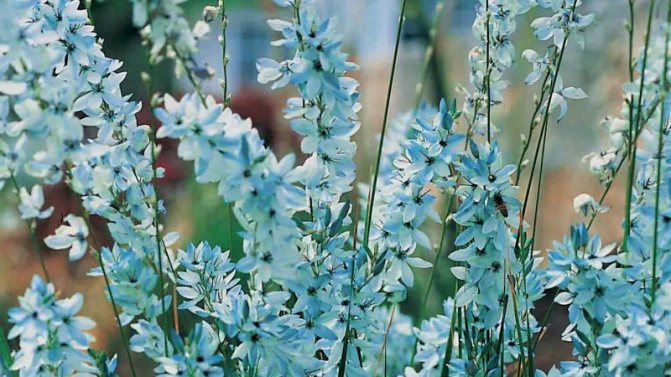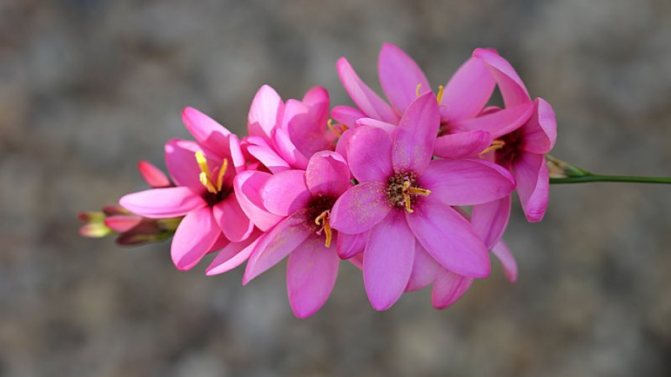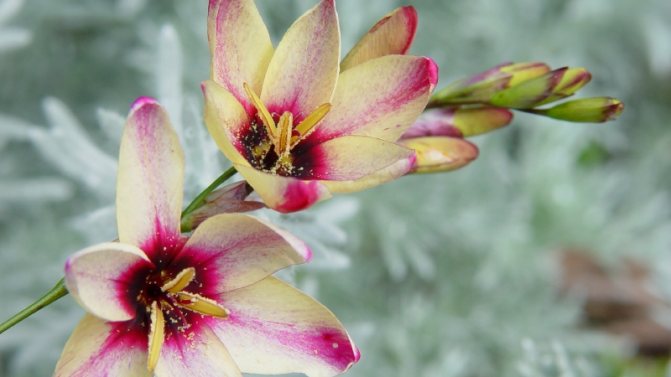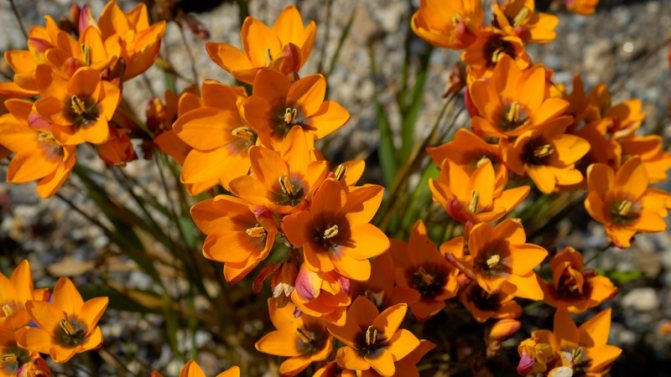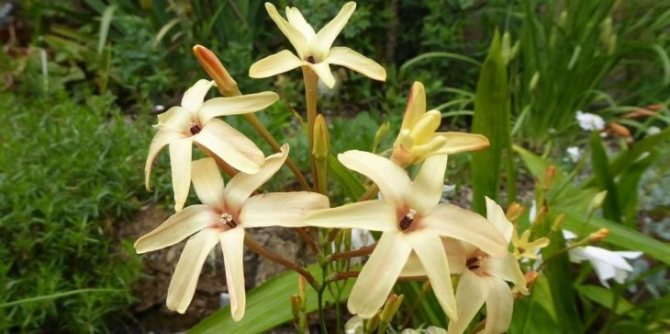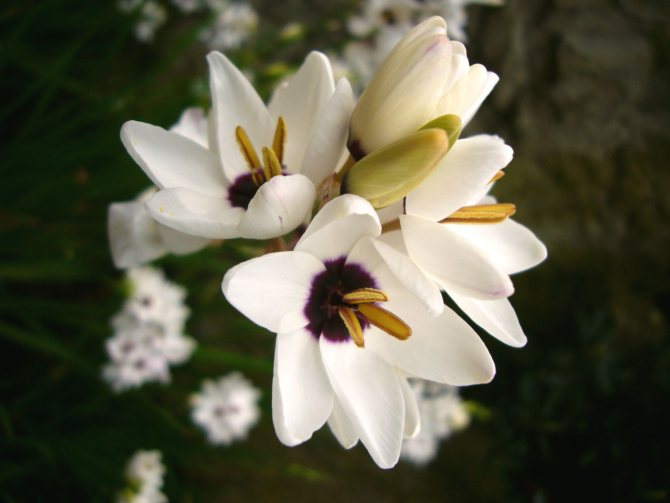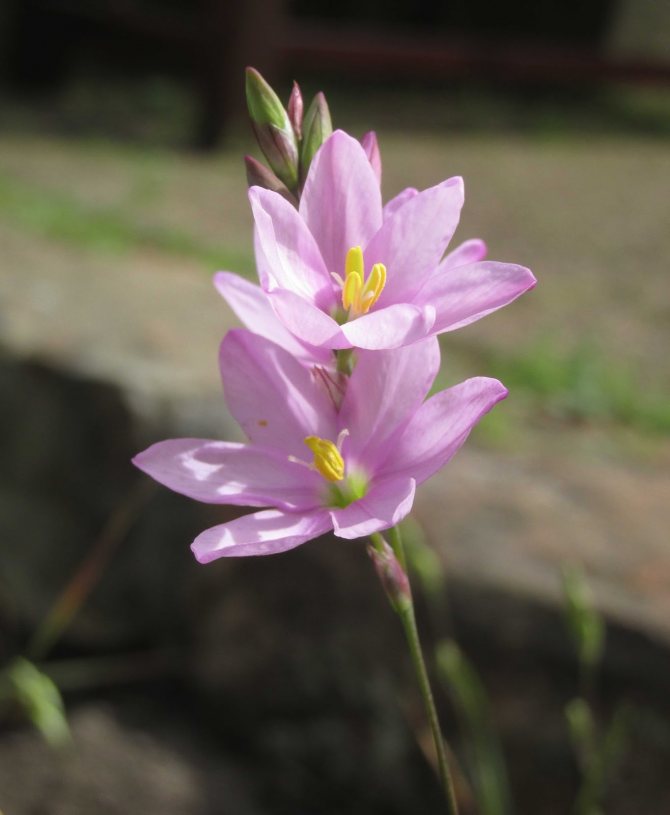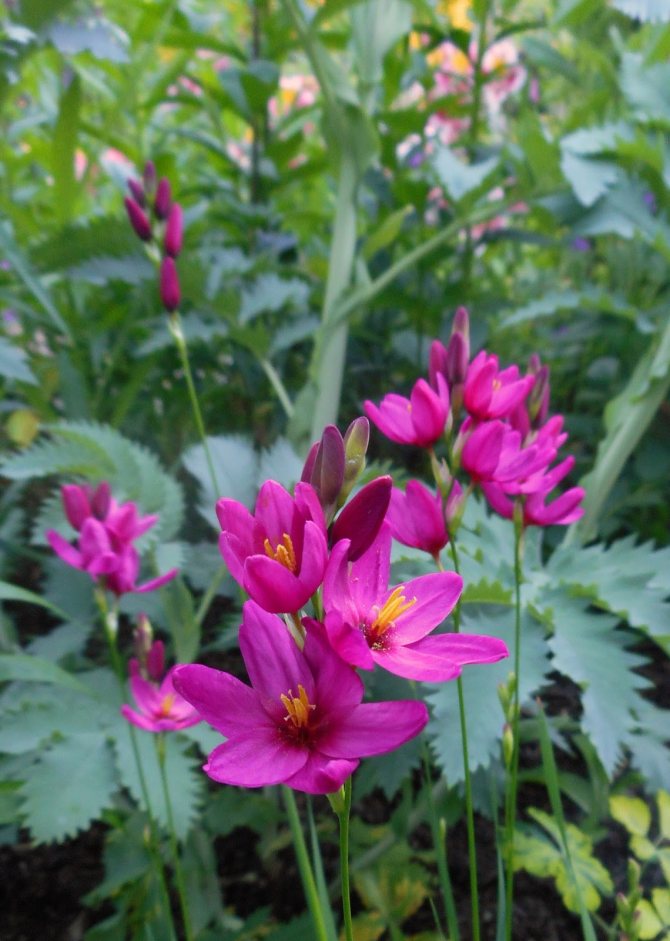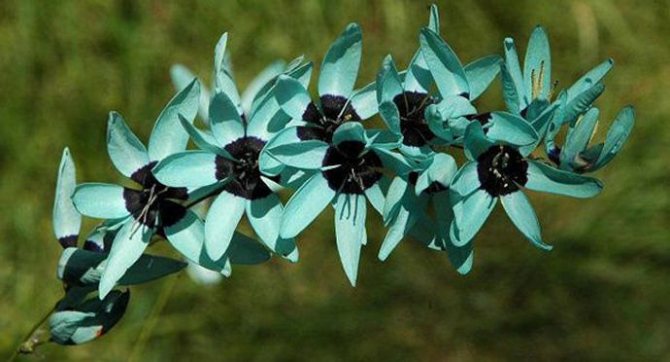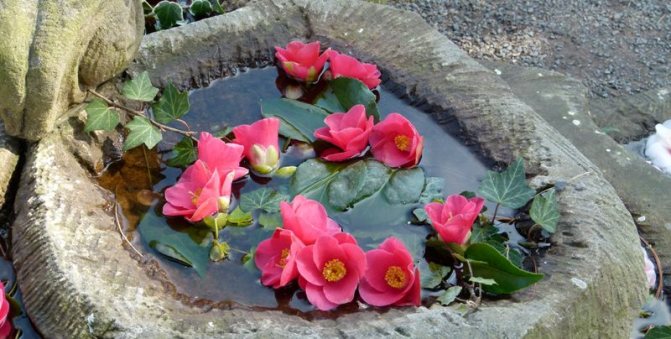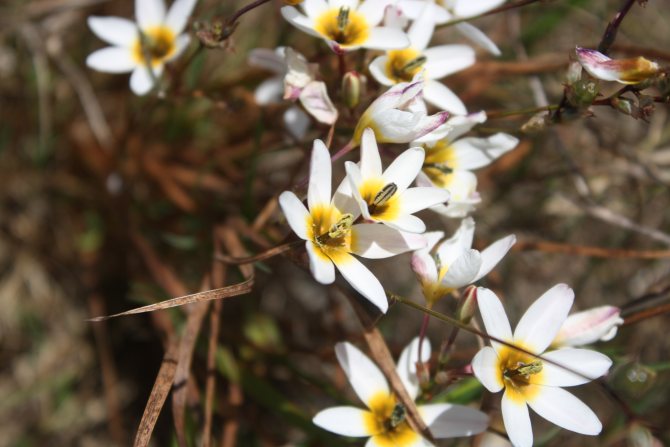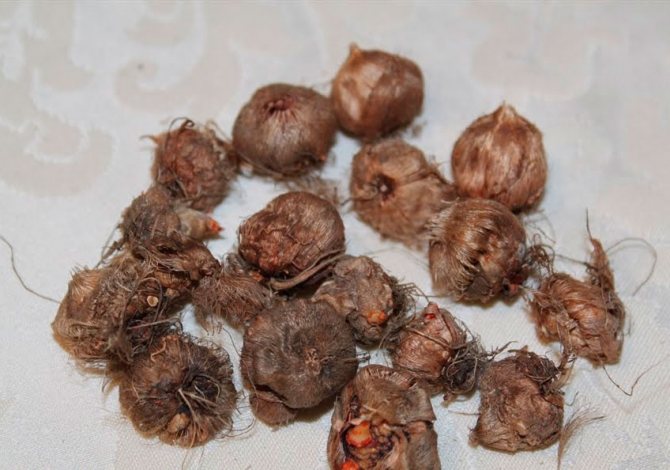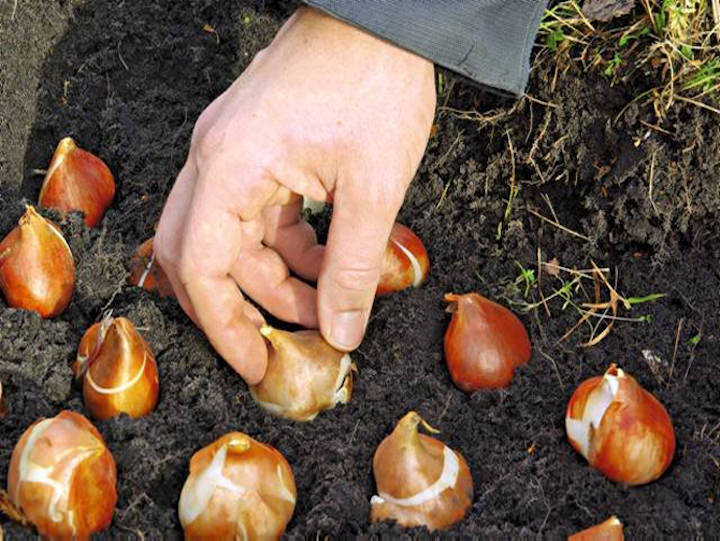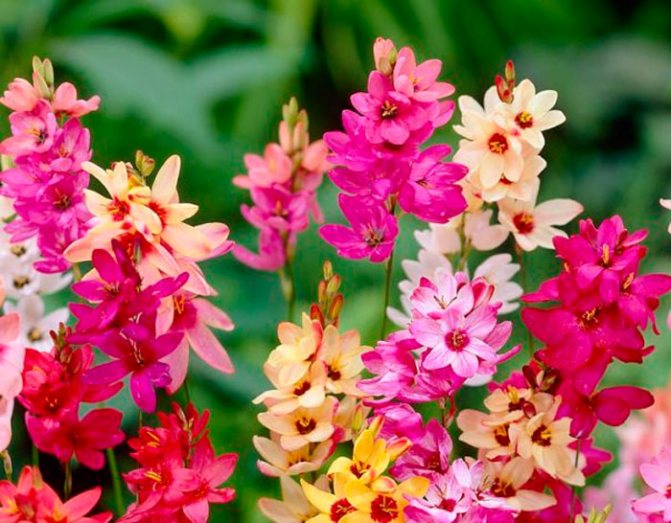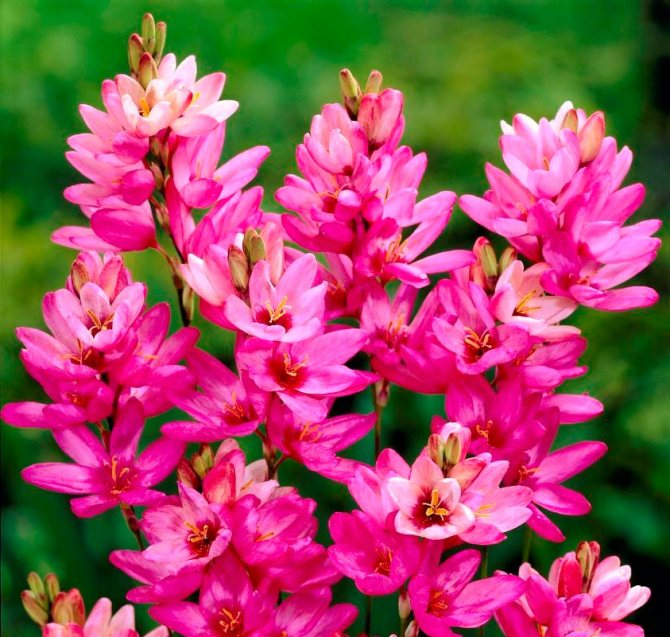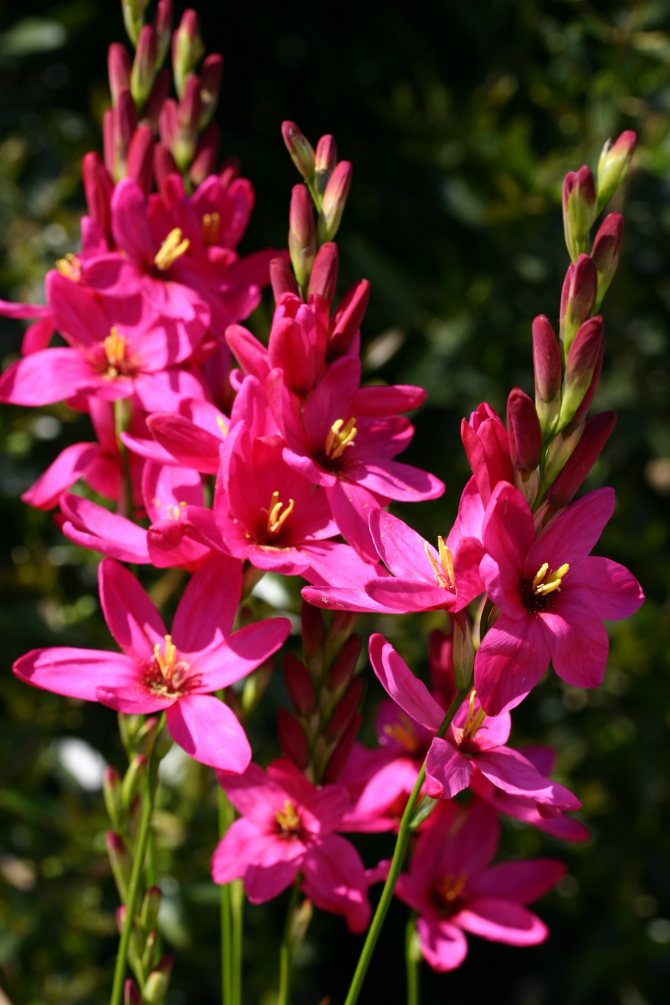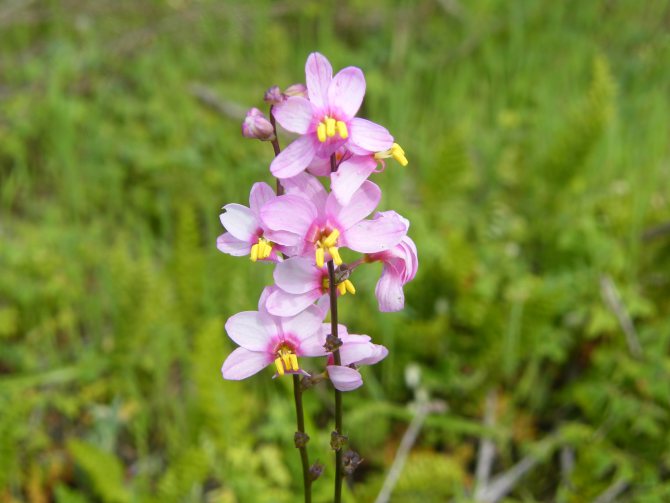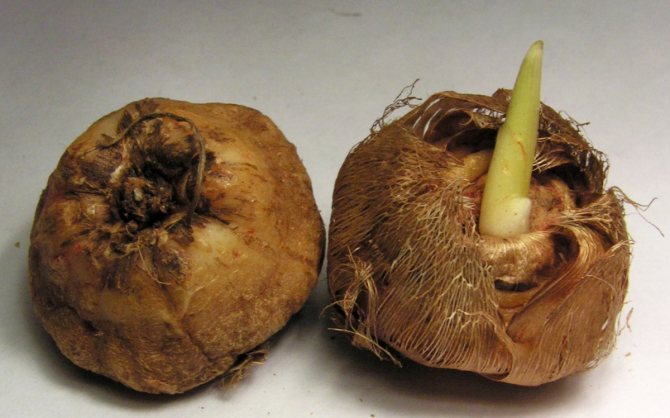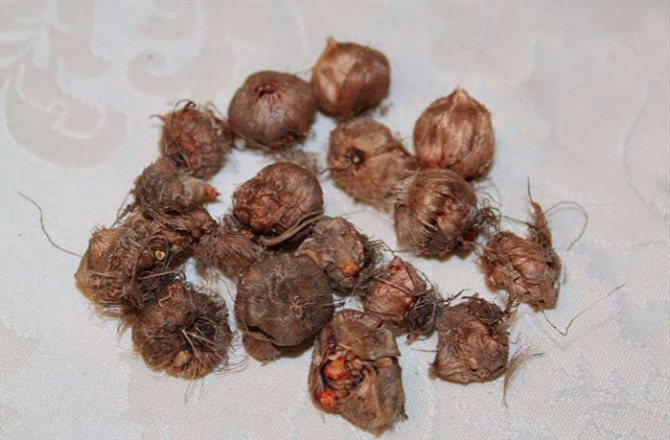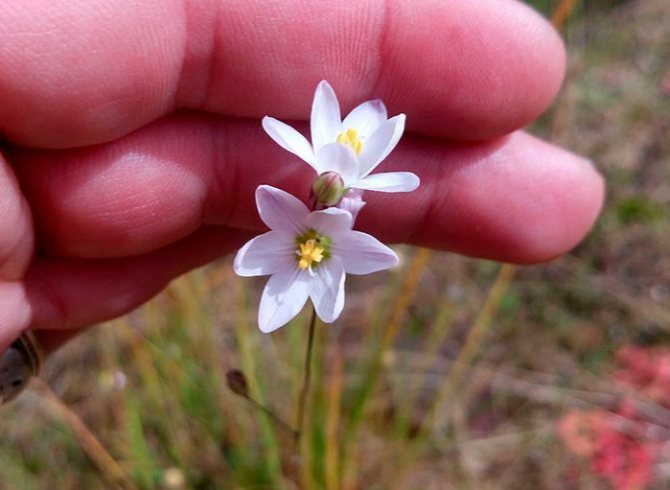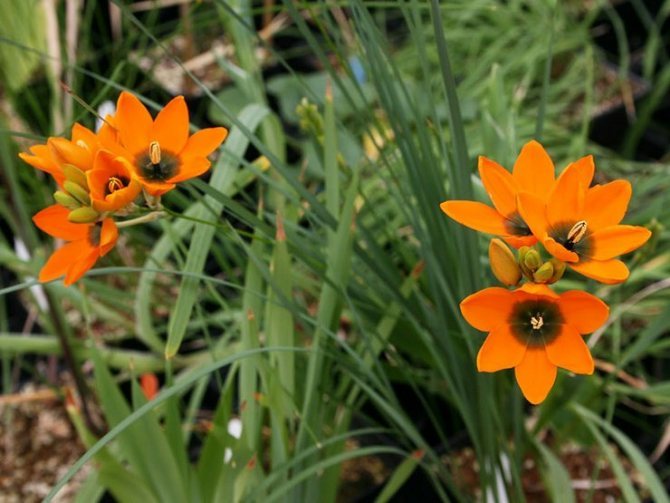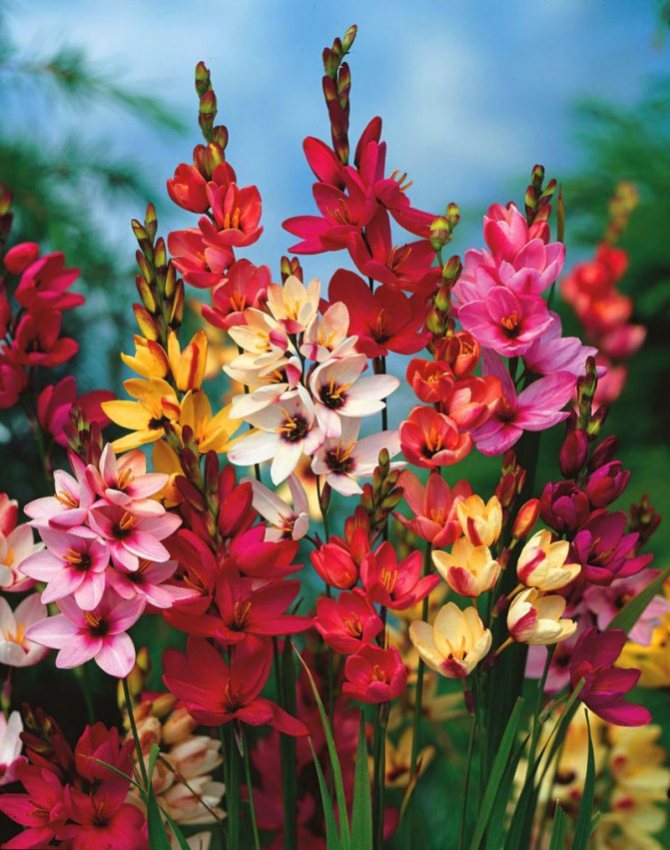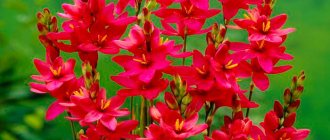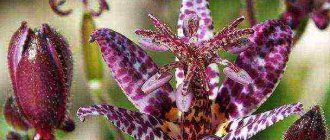Most of the most beautiful garden flowers come from countries with warm and humid climates. Some of these tropical plants, such as dahlias, cannes and gladioli, are found almost anywhere, while others can only be found in the collections of keen growers.
One of these rare plants is ixia... Growing and caring for this tropical miracle in the open field does not present any particular difficulties, it is much more difficult to preserve corms in the winter.
Ixia - herbaceous perennial, but in the middle zone (Siberia) the corms do not hibernate, and they must be dug out annually.
Description of the ixia flower
Ixia flower belongs to corms. The growth of an adult ixia varies from 15 to 70 cm. It looks elegant and sophisticated: thin, long stems, narrow leaves, in the shape of swords. Flowers with a diameter of 2.5 to 5 cm, wide open. There can be about 10 of them on one peduncle. The flower is formed by 6 petals of different colors: here and delicate white, pink and brighter colors, such as yellow and red.
The color becomes denser as the center of the inflorescence approaches. The inside can be burgundy, brown and even black. Flowers begin to delight with their flowering in late spring (in May) or at the very beginning of summer.
At night and in gloomy weather, when the sky is overcast with clouds, the flowers cover the buds. Ixia has a light, unobtrusive, delicate aroma.
Plant appearance
Ixia flower is native to South Africa, from a warm exotic place, but nowadays you can see it more and more often in Russia. Its height reaches about 50-70 centimeters, has thin erect stems. Ixia has a rich color scheme and can be:
- red;
- pink;
- yellow;

white tint.
Its bell-shaped flowers will not leave anyone indifferent. The blooming season of this flower is in July - August, and it continues to bloom for about four weeks. However, at night, the flower closes, as if falling asleep, so that the next day it will also continue to please the eye. The plant does not have a strong odor, but still its aroma is able to attract the attention of many insects and butterflies. Previously, the juice was used for catching birds, as it is very sticky. There are a large number of Ixia varieties.
In total, there are more than 20 species of this flower.... Ixia mix is one of the most colorful species of this plant, is a multi-colored inflorescence, consisting of different color sets.
In which month tulips are planted in autumn: timing and planting technology
Ixia planting in open ground
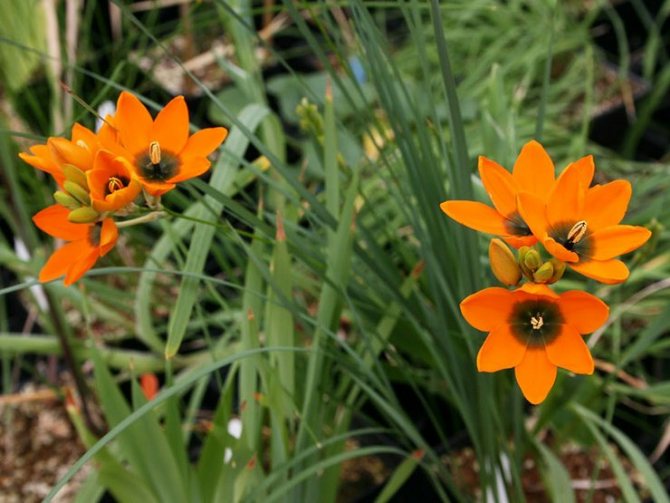

Ixia feels good in open field conditions. In order for it to take root well in the new conditions and to please with beautiful flowers and aroma, you need to know some of the features of planting and caring for ixia.
When to plant Ixia
The beginning of planting depends on the climatic conditions of the territory. So, in the south, Ixia is planted already in April-May, as well as in mid-autumn-November. In less favorable climatic conditions, planting is carried out exclusively in the spring-summer period. Even at a slight minus temperature (-1, -2 degrees), the bulbs can be damaged.
Every season, they carry out prophylaxis against plant damage by pests and diseases.It is recommended to grow Ixia in a new location every year. It should not be blown out and out of direct sunlight. It is advisable that there are no trees nearby.
Ixias love nutritious, humus-rich foods. The acidity of the earth should be neutral. Plants should not be planted in places with stagnant moisture.
How to plant Ixia
Before planting Ixia, the soil is prepared in advance: they dig up the earth along with the compost. In the case of too dense soil, sand is added to the soil. It makes the soil breathable and water-permeable without forming stagnation.
Planting material is carefully selected. Healthy, plantable bulbs are strong and resilient. Those that are dry or already covered with mold are not planted.
Prepare seed holes, lining the bottom with nutritious soil. Seeds are placed at a depth of 5 to 8 cm. Bulbs are placed at a distance of 10 to 12 cm. Children and detached tubers are placed at a distance of 8 to 10 cm.
Ixia seeds are not watered immediately after planting. Only soil mulching is carried out. For mulching, organic matter is used, covering the soil with a layer from 2 to 3 cm thick.
Ixia bloom does not need to be rushed. Those with large tubers can bloom during the planting season. Plants with smaller tubers, as a rule, bloom only the next or even the 2nd year. Will have to wait.
Choice of place and timing of boarding
Since Ixia is a southern plant, it likes good lighting and sufficient moisture. It is very important to choose the right place in the garden for planting it. The site should be chosen with good drainage so that there is no stagnation of water. A place for planting ixia in the garden must be prepared in advance. For this, the soil is dug up, fertilized with rotted manure or humus, if necessary, sand is poured for looseness. You can also add components to the soil such as:
- wood ash - 300 g;
- superphosphate - 70 g;
- magnesium - 20 g.
Too heavy soil is not suitable for Ixia. It will not bloom well in such soil, so river sand is added to it (1 bucket per 1 m2 of land)
A nutrient mixture is laid in the pit and spilled well.
Ixia care in the garden
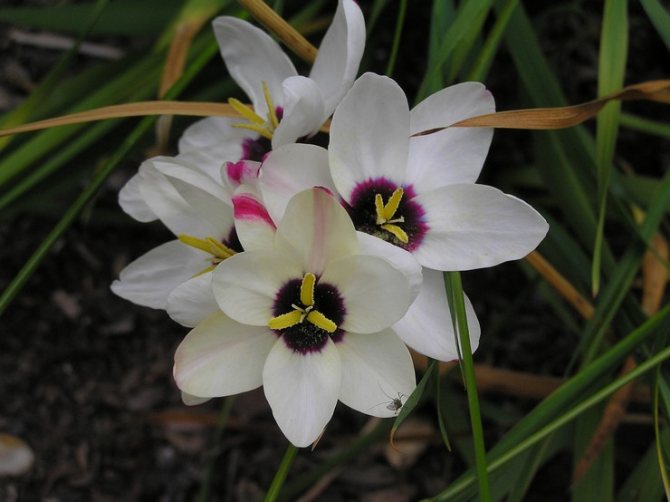

To get a beautiful, healthy, flowering plant, you need to make an effort: know the rules of growing and care, and, of course, follow them. In general, planting and caring for Ixia is quite simple, even a novice florist can handle it. But there are some nuances, they are described below.
The main condition required for growing Ixia is the presence of a sufficient amount of sunlight, a high level of ambient temperature, and air humidity.
In order for ixia to open to the maximum, you will need to select a sunny piece of land. Shading is not appropriate. Grown in the shade of Ixia lose their decorative appearance. Their petals become too thin and elongated. In shady conditions, the plant will lose its bright color and become faded.
Correct care for ixia consists in moderate and timely moistening of the soil, applying top dressing, spraying (especially in the evenings), loosening the earth and weeding. It is advisable to carry out preventive measures against pests and pathogens.
Watering and feeding
When planting seeds in the soil, watering is not carried out. Only after a couple of weeks, when shoots appear, do they begin to moisten the soil. From this time period, watering becomes regular. Pour with settled water, room temperature. For better flowering, drugs that stimulate growth and flowering are added to the water for irrigation. The amount of introduced moisture is increased during the period of bud formation and the appearance of flowers. At the end of flowering, watering is also finished.
Ixia loves dressings created specifically for members of her family - Bulbous. However, it also responds well to organic fertilizers. The beginning of fertilization is the beginning of the summer period.When the plant fades, feeding is stopped.
Ixia in winter
At the end of flowering, the plants are dug out after a while. As a rule, at the end of July. They need time to lie in the ground in order to make reserves for the winter, having absorbed a lot of useful substances from the ground. After that, the tubers of Ixia are dug out of the soil and dried thoroughly under good ventilation. Next, they are soaked in an antibacterial solution of potassium permanganate and thoroughly dried again. They are laid out in prepared dry boxes and stored in a dry and cool place. Ideal conditions are a refrigerator compartment for storing vegetables.
The next disembarkation is carried out according to the scheme described above. The disembarkation time will depend on the climatic conditions. By the way, Ixii are sometimes planted for a landing. It is very beautiful: there is snow outside the window, and beautiful flowers at home.
Where there are no subzero temperatures in winter, Ixia are left in the ground for the whole winter, removing yellow, wilted flowers and leaves. In this case, the site must be covered from above. This can be a layer of sawdust, straw, or dry soil.
Care
In order to grow a real decoration of a garden, balcony or room, Ixia must be properly looked after. Comprehensive care includes:
- watering;
- mulching;
- loosening;
- pruning;
- treatment;
- preservation of bulbs in winter conditions.
Growing Ixia will not take a long time from the gardener.
The first watering of Ixia is performed only after the sprouts hatch. This will happen approximately 2-3 weeks after planting. Further, you need to water the plant intensively, especially during the period of budding and flowering. It is advisable to add complex fertilizers to the water for irrigation, which will make the flowers more saturated in color, and also increase the flowering time.


Fertilizer
Mulching and loosening should be done immediately after planting and repeated periodically throughout the summer. These procedures will help to retain moisture at the roots and prevent crust formation on the soil, thereby providing oxygen to the bulb. Mulching is carried out with peat, sawdust or dry foliage.
Reproduction of ixia


Ixia is propagated in two ways:
- children;
- dividing the rhizome.
In the first method, the children are separated from the mother's tuber and placed on the finished wells. Before planting, all cuts are made with charcoal powder. Babies bloom in the 2nd - 3rd years after planting.
When propagated by a tuberous bulb, it is divided into parts with a knife. The division is carried out in such a way that a peephole, a bottom with the rudiments of the root system are present on the separated part. The places of the cuts are also sprinkled with coal powder. You can use ash or brilliant green. A plant planted in this way can bloom this year.
Diseases and pests
Ixia is very resistant to diseases and pests, especially if preventive measures are taken.
Most propagation is carried out using bulbs, so they should be protected. To protect against the occurrence of fungal diseases, carry out the pre-planting treatment as described earlier. If trouble happens, the bulb will become overgrown with fungal spores (mold will appear), the bulb will soften and begin to rot. Avoid waterlogging the soil and inspect the bulbs during winter storage. Infected bulbs must be set aside from healthy ones; just in case, treat the latter with a fungicidal preparation. If the lesion is insignificant, cut off the moldy areas and treat the cuts with wood ash, you can lower the bulb for a few minutes in a light solution of potassium permanganate.
The only insect threatening Ixia planting is aphid. Use a garden sprayer to spray the insecticide solution on the bushes. This will serve as protection for 30-35 days, if necessary, carry out several treatments per season.
Types and varieties of ixia with a photo
There are several types of Ixia known today.
Green-flowered Ixia (Ixia viridiflora)
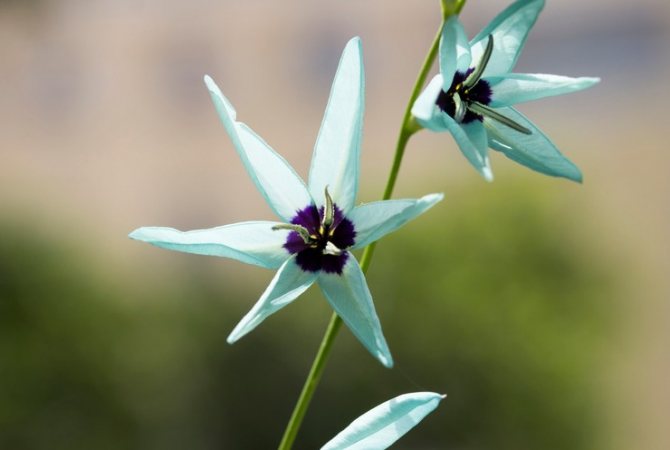

Magnificent beauty, unusual flower. The petals are greenish and the center is purple-black. This species is rare: it is not easy to acquire its seeds.
Ixia spotted (Ixia maculata)


The plant has a small diameter bulb (up to 3 cm). The stem is abundantly covered with leaves and reaches 40 cm. It has inflorescences in the form of spikelets. There are narrow leaves at the roots. Flowers I slam the buds for the night. Closed - their size is only 4 cm. The color of this type of ixia is the most diverse, the middle is dark.
Chinese Ixia (Ixia chinensis)


Grows in the Far East. Today it belongs to the endangered species. The length of the rhizome is short. Shoots come in very different sizes: from 50 to 150 cm. At the very bottom, at the roots, there are from 5 to 8 leaves like swords. They reach a length of half a meter, with a width of 4 cm.
The flowers have a beautiful bright color: red-brown or yellow with spots. The diameter of the flower when open is 7 cm. From 12 to 20 flowers form a fan.
The flower opens its bud at the beginning of a sunny day. After 17 hours, wilting occurs. The decorative variety - flava - with a huge number of yellow-orange flowers is especially popular. Graceful, thin leaves form a fan, overlapping each other in 3/4. A variety such as purpurea is also popular. Has flowers of a yellow-red hue.
Ixia hybrid (Ixia x hybrida)
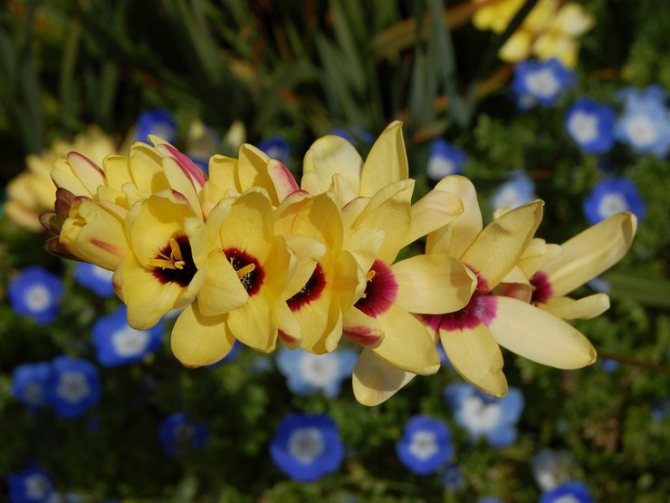

The height of an adult ixia is up to half a meter. Narrow leaves are arranged in 2 rows. Peduncles are collected from 6 to 12 flowers per cluster. The spikes of flowers in the form of funnels have a wide variety of shades. The core can be dark red, brown.
Hybrid Ixia blooms at the very beginning of the spring period, for 21 days. This species has been cultivated since 1770. The most famous, common varieties:
- Blue Bird is a variety with beautiful blue and white flowers.
- Hogard - differs in a gentle creamy shade.
- Rose Imperial - has pastel pink inflorescences.
- Hollands Glory and Market are varieties with golden yellow flowers.
- Mabel - stands out in a purple, carmine red hue.
- other.
Ixia is an elegant, beautiful and at the same time easy-to-care plant. Pleases with its flowering for 3 weeks. There are many types of ixia. According to information data - from 40 to 60 species. Among them there are different colors that give the plant a certain character. Ixii is an excellent choice for decorating a summer cottage. They emit a delicate, subtle fragrance. With proper care, they will delight with their flowering every season.
Garden flowers Perennial flowers
How to plant
The easiest way to plant the plant is with corms, which are similar in appearance to tulip bulbs. In the middle lane and the Moscow region, Ixia is planted only in the spring, since it does not tolerate frost at all. In southern regions, with warm winters, it can be planted before winter.
Healthy ixia bulbs are planted in a prepared bed when the soil warms up. Around April - May. The tubers are immersed in the ground to a depth of 5 - 7 cm, the distance between the plants depends on the height of the variety, and is 15 - 25 cm. The plantings are mulched with a small layer of humus (2 - 3 cm), do not watered. Seedlings will have to wait up to 3 weeks.
When planting bulbs in the south, a bed with ixia is mulched with a layer of sand, 3-4 cm thick.


